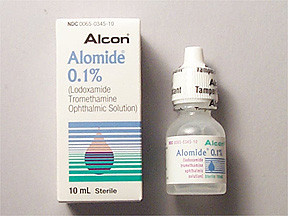LODOXAMIDE - OPHTHALMIC
PHONETIC PRONUNCIATION: (low-DOX-uh-mide)
COMMON BRAND NAME(S): Alomide
GENERIC NAME(S): lodoxamide tromethamine
Uses
USES: This medication is used to treat certain allergic eye conditions (vernal keratoconjunctivitis, vernal conjunctivitis, vernal keratitis). It prevents itching of the eyes that can occur with these conditions. Lodoxamide is known as a mast cell stabilizer. It works by blocking certain natural substances (histamine, leukotriene) that cause allergic symptoms.
How to use LODOXAMIDE - OPHTHALMIC
HOW TO USE: To apply eye drops, wash your hands first. To avoid contamination, do not touch the dropper tip or let it touch your eye or any other surface. It is best to not wear contact lenses while using this medication. This medication is used in the affected eye(s), usually 4 times daily or as directed by your doctor. Treatment may be continued for as long as 3 months. Tilt your head back, look upward, and pull down the lower eyelid to make a pouch. Hold the dropper directly over the eye and place 1 drop into the pouch. Look downward and gently close your eyes for 1 to 2 minutes. Place one finger at the corner of the eye near the nose and apply gentle pressure. This will prevent the medication from draining away from the eye. Try not to blink and do not rub the eye. Repeat these steps if your dose is for more than 1 drop and for the other eye if so directed. Do not rinse the dropper. Replace the dropper cap tightly after each use. If you are using another kind of eye medication (e.g., drops or ointments), wait at least 5 minutes before applying other medications. Use eye drops before eye ointments to allow the eye drops to enter the eye. Use this medication regularly in order to get the most benefit from it. To help you remember, use it at the same times each day. Continue using it for the full time prescribed. It may take up to several days of continued use to see a relief in symptoms. If immediate relief of symptoms (itching) is needed, use other quick-relief medication (such as eye drops containing antihistamines, decongestants, or nonsteroidal anti-inflammatory drugs-NSAIDs) along with lodoxamide as directed by your doctor. Tell your doctor if your condition persists or worsens.
Side Effects
Precautions
Interactions
Overdose
Images
Reviews
Faq for LODOXAMIDE - OPHTHALMIC
Lodoxamide ophthalmic is an eye medication used to relieve itching and redness caused by allergies.
Lodoxamide ophthalmic works by preventing the release of certain substances in the body that cause allergic reactions, such as histamine.
Common side effects of Lodoxamide ophthalmic may include eye irritation, burning or stinging sensation, blurred vision, and headache. If you experience severe or persistent side effects, it is important to contact your doctor.
Lodoxamide ophthalmic should be used as directed by your doctor. Typically, it is applied to the affected eye(s) twice a day. You should wash your hands before and after using the medication and avoid touching the tip of the dropper to prevent contamination.
It is generally recommended to remove contact lenses before using Lodoxamide ophthalmic. You can wait at least 10 minutes after applying the medication before reinserting your contact lenses.
The effects of Lodoxamide ophthalmic may vary from person to person. Some individuals may experience relief within a few minutes, while others may require a few days of treatment before noticing improvement.
It is advisable to consult with your doctor before using Lodoxamide ophthalmic if you are pregnant or breastfeeding. They can assess the potential risks and benefits for your specific situation.
If you miss a dose, skip the missed dose and continue with your regular dosing schedule. Do not double the dose to make up for the missed one.
There are no significant drug interactions reported with Lodoxamide ophthalmic. However, it is always important to inform your doctor about all the medications you are taking, including prescription, over-the-counter, and herbal products.
Disclaimer
IMPORTANT: HOW TO USE THIS INFORMATION: This is a summary and does NOT have all possible information about this product. This information does not assure that this product is safe, effective, or appropriate for you. This information is not individual medical advice and does not substitute for the advice of your health care professional. Always ask your health care professional for complete information about this product and your specific health needs.

No Reviews Yet